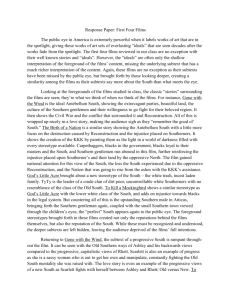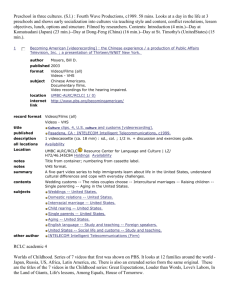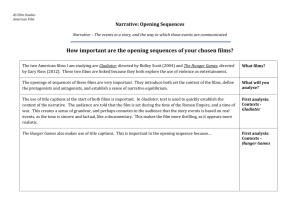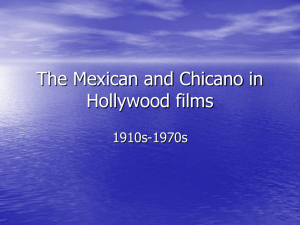Presentation
advertisement
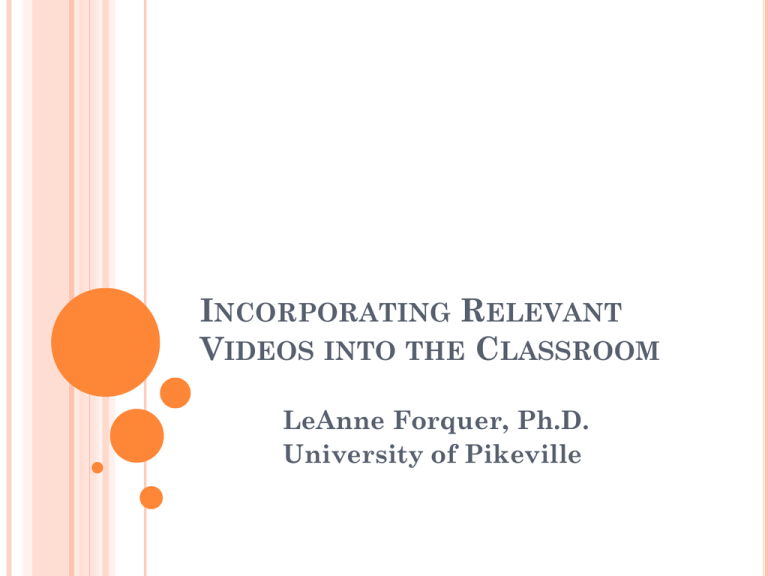
INCORPORATING RELEVANT VIDEOS INTO THE CLASSROOM LeAnne Forquer, Ph.D. University of Pikeville OVERVIEW Why should you incorporate video clips into your courses? How do you incorporate video clips into your courses? A few cautions regarding the use of videos in class? How do you evaluate students on the videos seen in class? Examples? WHY USE VIDEOS IN THE CLASSROOM? Proctor and Adler (1991) offered the following reasons to support using films in the classroom (as cited in Matzenbacher, 2006): Heightens student interest without sacrificing academic rigor. Utilizes an existing and readily available resource with which students are familiar. Allows classes to observe and evaluate concepts in action. Exposes students to worlds beyond their own. Provides affective as well as cognitive experiences through vicarious involvement. Offers opportunities for discussion, clarification, and personal assessment. WHY USE VIDEOS IN THE CLASSROOM? Others have shown that using films in the classroom may stimulate critical thinking (Boyatzis, 1994; LeBlanc, 1998). In addition, Zelley and Messman (1997) reported that films are useful for improving the learning process because students demonstrate greater interest, motivation, and comprehension of the concepts being discussed in class (as cited in Matzenbacher, 2006). Zelley and Messman (1997) also stated that films provide students with the opportunity to witness concepts in action and then apply, synthesize, and analyze them according to what they learned in class (as cited in Matzenbacher, 2006). HOW DO YOU DO THIS? Showing an entire film. If it contains multiple concepts related to the course content. If it is necessary for students to see the whole film to fully understand the concept/process. May want to stop the film periodically to discuss important concepts. Have them watch films outside of class time (library reserve, rent). Showing film clips: Requires less class time. Reduces the likelihood of students being distracted by irrelevant information. Students are better able to maintain their focus. A FEW CAUTIONS? Always preview the video before showing in class so that there will be NO surprises. Add disclaimer to the syllabus or in class before beginning a film IF the clip involves nudity, violence, or profanity. Example - “During the course of the semester we may view clips or entire films that contain nudity, sexuality, violence, and/or profanity. These films will be carefully selected to offer students valuable learning experiences regarding important course concepts. All films will be announced in advance, either on the syllabus or in class. Students who would prefer not to watch a film for any reason should speak with the instructor prior to the scheduled viewing to make alternative arrangements” (Matzenbacher, 2006). A FEW CAUTIONS? Videos don’t always present an accurate view of the course concept. What can be done about this? Choose clips carefully so that are as accurate as possible. Use inaccuracies to spark classroom discussion about what was wrong in the video and how it could be made more accurate. Use inaccuracies to teach students to critically examine the information presented on television and in the movies. EVALUATION Class discussion. Not all students equally likely to participate. May include participation points as a component of grade for the course. Consider using online discussion forums. Quizzes/test questions. Students more attentive during viewing if they expect questions about the clip to be on a test/quiz. I prefer to use short answer questions based on the videos seen in class; however you could also use multiple choice, true/false, or matching. Writing assignments. EXAMPLES Ethics of Research. Learning and Memory. Seabiscuit. A Clockwork Orange. Momento. Psychological disorders. Ghostbusters. V for Vendetta. As Good As it Gets. The Three Faces of Eve. A Beautiful Mind. American Psycho. Lifespan Development. For the Love of Nancy. Mean Girls. The Breakfast Club. American Beauty. Iris. REFERENCES Boyatzis, C. (1994). Using feature films to teach social development. Teaching of Psychology, 21 (2), 99-101. LeBlanc, L. (1998) Observing reel life: Using films to teach ethnographic methods. Teaching Sociology, 25, 62-88. Matzenbacher, D. (2006). The blockbuster approach: A guide to teaching Introductory Psychology with video. Upper Saddle River, NJ: Pearson.












